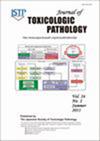大鼠黄体毒性评价
IF 0.9
4区 医学
Q4 PATHOLOGY
引用次数: 4
摘要
黄体(CL)是排卵后在卵巢中形成的内分泌腺,分泌类固醇激素黄体酮(P4)。P4在发情和月经周期、着床和妊娠中起着关键作用。啮齿动物的不完全发情周期稳定持续4-5天,在每个发情周期阶段都可以区分其形态特征。在大鼠卵巢中,CL主要有两种类型:由于当前排卵而新形成的CL(新CL)和先前发情周期遗留的CL(旧CL)。在黄体退化过程中,Sprague-Dawley大鼠在四个发情周期后CL几乎完全退化。啮齿类动物CL的P4分泌受合成和分解代谢之间的平衡调节。一般来说,黄体毒性应通过考虑尸检和死后数据进行评估。每天的阴道涂片观察提供了关于黄体毒性的有用信息。在组织病理学检查中,不仅要仔细检查卵巢和CL,还要仔细检查其他相关组织和器官,包括子宫、阴道、乳腺和肾上腺,以探索黄体变化。本文综述了CL在大鼠体内的组织学和功能特征,并提出了具有代表性的黄体毒性变化,以改进临床前毒性研究中的黄体毒性评估。本文章由计算机程序翻译,如有差异,请以英文原文为准。
Luteal toxicity evaluation in rats
The corpora lutea (CL) are endocrine glands that form in the ovary after ovulation and secrete the steroid hormone, progesterone (P4). P4 plays a critical role in estrous and menstrual cycles, implantation, and pregnancy. The incomplete rodent estrous cycle stably lasts 4–5 days and its morphological features can be distinguished during each estrous cycle stage. In rat ovaries, there are two main types of CL: newly formed ones due to the current ovulation (new CL), and CL remaining from prior estrous cycles (old CL). In the luteal regression process, CL were almost fully regressed after four estrous cycles in Sprague-Dawley rats. P4 secretion from CL in rodents is regulated by the balance between synthesis and catabolism. In general, luteal toxicity should be evaluated by considering antemortem and postmortem data. Daily vaginal smear observations provided useful information on luteal toxicity. In histopathological examinations, not only the ovaries and CL but also other related tissues and organs including the uterus, vagina, mammary gland, and adrenal glands, must be carefully examined for exploring luteal changes. In this review, histological and functional characteristics of CL in rats are summarized, and representative luteal toxicity changes are presented for improved luteal toxicity evaluation in preclinical toxicity research.
求助全文
通过发布文献求助,成功后即可免费获取论文全文。
去求助
来源期刊

Journal of Toxicologic Pathology
PATHOLOGY-TOXICOLOGY
CiteScore
2.10
自引率
16.70%
发文量
22
审稿时长
>12 weeks
期刊介绍:
JTP is a scientific journal that publishes original studies in the field of toxicological pathology and in a wide variety of other related fields. The main scope of the journal is listed below.
Administrative Opinions of Policymakers and Regulatory Agencies
Adverse Events
Carcinogenesis
Data of A Predominantly Negative Nature
Drug-Induced Hematologic Toxicity
Embryological Pathology
High Throughput Pathology
Historical Data of Experimental Animals
Immunohistochemical Analysis
Molecular Pathology
Nomenclature of Lesions
Non-mammal Toxicity Study
Result or Lesion Induced by Chemicals of Which Names Hidden on Account of the Authors
Technology and Methodology Related to Toxicological Pathology
Tumor Pathology; Neoplasia and Hyperplasia
Ultrastructural Analysis
Use of Animal Models.
 求助内容:
求助内容: 应助结果提醒方式:
应助结果提醒方式:


